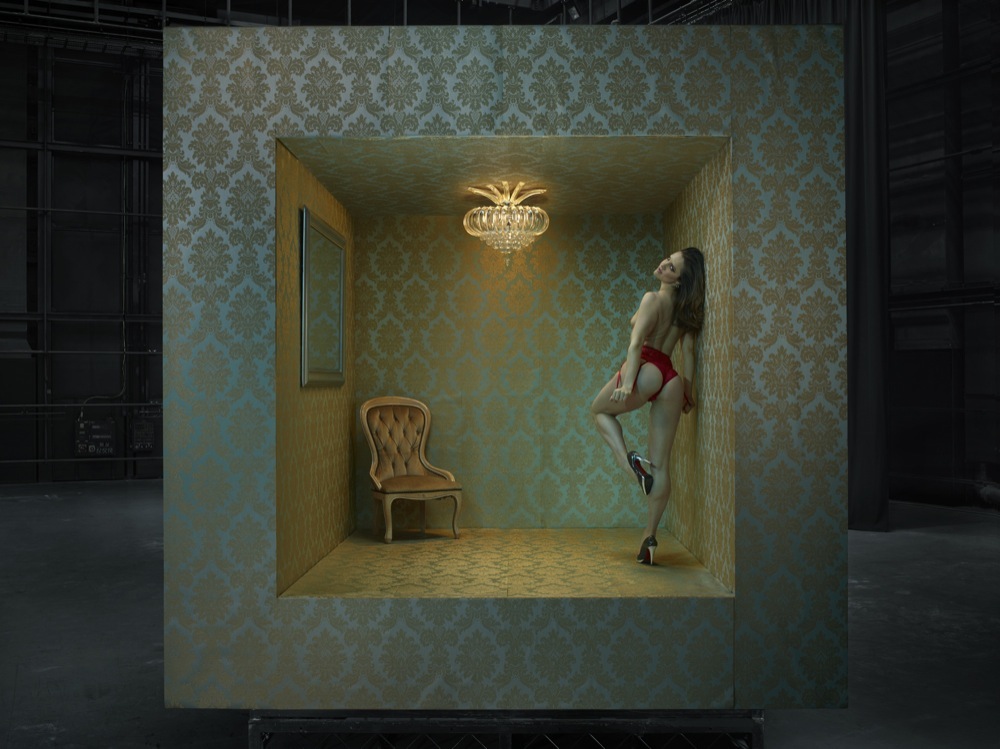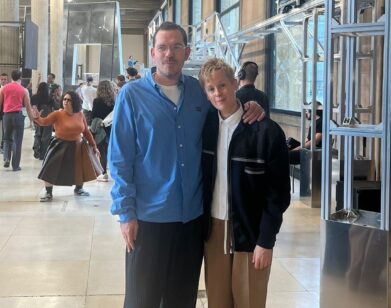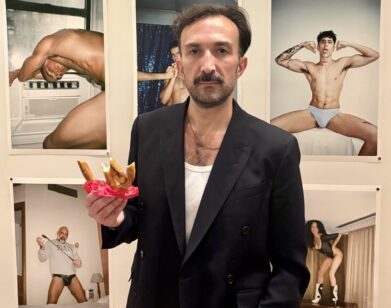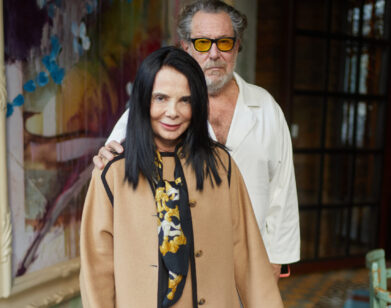Art and Agency in The Act
In her new fine art series “The Act,” photographer Julia Fullerton-Batten addresses the sex industry through the women who choose to work within it. Presented individually on tailor-made sets, her subjects include escorts, porn stars, burlesque performers, strippers, erotic dancers, and a dominatrix. Each image is accompanied by an interview, conducted by Fullerton-Batten herself. At the heart of the project is an exploration of agency—as an adult, as a woman, as a sexual being.
“I wanted to approach the [sex industry] in a completely different way,” Fullerton-Batten explains over the phone. “Most photographers do more behind-the-scenes—the nitty-gritty, black-and-white. It’s normally quite negative. I wanted to show something very beautiful, very aesthetic,” she continues. “It’s meant to be a reflection of the modern woman and the choices that we have.”
Raised between Germany, the U.S., and the U.K., and currently based in London, Fullerton-Batten picked up a camera as a young teenager. “My father used to do photography as a hobby,” she recalls. “We lived in Pennsylvania, and he would travel to New York and come back with all these amazing images of women in miniskirts running down Fifth Avenue.”
After beginning her career in advertising, Fullerton-Batten broke into the art world over a decade ago with “Teenage Stories,” her study of girlhood and adolescence. Since then, she has exhibited her images across the world at the National Portrait Gallery in London, the Pompidou in Paris, and the Museum of Contemporary Art Shanghai. For different series over the years, she photographed both professional and non-professional models. In 2015’s “Feral Children,” for example, she had child actors recreate scenes of famous children raised outside of society. In 2013’s “Blind,” the focus is on the subject’s personal stories.
EMMA BROWN: How long does it take from when you first think of a project like this to launching it?
JULIA FULLERTON-BATTEN: I would say nearly a year. Each project is different. This particular one took a long time. I had just finished shooting “Feral Children” and I really wanted to do a project on sex industry; I thought it was really fascinating. I wasn’t sure how I was going to even approach these girls, so I had a casting director. It took a while to get girls to come to my house, for me to meet them, to hear their stories, and then to slowly start working on the ideas. Normally, I will hire a location, and I’ll adapt the location with my props and styling. This is the first time in my arts projects where I’ve totally created the set in the studio. I kept the outer space of the set because I wanted it to look like the girls were in a staged set, rather than pretending the set is real. That took a long time working with a set designer. What really puts me under pressure is, it takes me such a long time to produce something like this, but then the shooting time is only five days. When I look at some of the behind the scenes filming, I’m always looking really intense. I love it when everything comes together, but it’s a lot of pressure. Because my background is in advertising, I approach it nearly like an advertising shoot, where everything is completely nailed down. Whenever I come to shooting, I know exactly what that girl is going to wear or what I’m trying to say in the image, what set I’ve created for her, what move I want her to do. I’ve got to be very flexible on the date but I try to nail it down as much as possible.
BROWN: Did the women have any say in their sets?
FULLERTON-BATTEN: Yes, they did. For example, Sasha Flexy, who’s an amazing pole dancer, self-trains at home. I wanted to create this living room space and make it look slightly Russian—or my interpretation of Russian—and old fashioned, where things are slightly clashing and the wallpaper is a little old-fashioned, and it’s got a carpet floor, and to put a pole in the middle of the room, with an old tape recorder and a couple of mirrors around her. I discussed it with her, and she loved the idea. With Eliza De Lite, who’s a burlesque dancer, I didn’t want to put her in this cliché 1920s background with a vintage look. I was discussing with her—”What’s this real environment you’ve been in?”—and she said sometimes she has to go into these very corporate hallways in a very simple, corporate hotel. By talking to them and meeting them and learning about how they approach their job and why they even got into it, we were also brainstorming how we could create the sets. So in a way they were very, very involved with the set design, but I didn’t go back and say, “What do you think of this wallpaper or this prop?”
BROWN: Does it feel extremely different when you’re shooting real people doing, to a certain extent, what they do in real life, than when you have people recreate scenes?
FULLERTON-BATTEN: I do like working with people who have not been photographed that much before. In this instance, the women are used to having a camera on them—not all of them, but obviously the porn stars are so used to it and so relaxed with it. Shadait, who is an escort, was quite shy about it. She’s not used to having a camera and all of these assistants running around and all of this attention. Her work is much more intimate, very one-to-one with a man. But she was happy to be a part of the project. I find it refreshing working people who also aren’t used to being in front of the camera and if they have that slightly shy attitude, I welcome it. I wanted their character to come out on the staged sets.
I make sure that I always meet every single person. I’m working on a new project already, and someone was saying, “Oh could we just do Skype?” And I said, “I really have to meet you. I really have to feel you perform in front of the camera. I want to discuss the shoot with you and what’s going to happen.” Just by sitting together one-to-one, I’ll get more out of the idea that I’m trying to create. For example, the two girls Ella and Chloe, it was only Ella who came in to see me. She’s a porn star, but I already had quite a few porn stars and I didn’t want to keep repeating the same idea over and over again. I wanted to make sure I had a huge variety of different girls coming from different avenues. Then she told me that she lives as a sex slave in her home environment—she lives with a dominatrix. She doesn’t get paid for it; it’s not her job, but her lifestyle. I’d never even heard of that before. I changed my whole shoot and got Chloe involved, who is the other sex slave girl. Chloe has her own dominatrix.
BROWN: Looking at Ella and Chloe, when I first saw the image I thought they were twins. Did you choose them because of that?
FULLERTON-BATTEN: No. Ella is a very petite, small girl with red hair and Chloe is like a bigger version of her. The height difference between them is enormous. I thought about putting Ella on a little platform, but I quite liked that size difference between them. [But] I was more intrigued about their stories, and that’s why I booked them rather than their looks. They happened to have quite interesting looks—very, very pale, slightly pre-Raphelite skin textures, and then this bright red hair. [laughs]
BROWN: When I was reading through the interviews with the subjects, one thing I found strange was that Morrigan, the dominatrix, said she didn’t view her sessions as sexual. Did you have a lot of surprises when you were talking to these girls?
FULLERTON-BATTEN: That surprised me. I think what she meant—she wanted to make that very clear in the interview—is that she never takes her clothes off and a man cannot touch her. She is in total control. She’s there to please the man, but in a very different way than, for example, than just giving him the blowjob. She’ll do odd things to him like mummification. Some of them are quite taunting in a way, and there are so many different options. Like she’ll tug at their nipples, and for them it might be sexual but for her it might not be. So I can see where she’s coming from but I still think it is sexual. I guess the other thing that surprised me were the sex slaves as a lifestyle. They were getting paid, in fact, when they were going off doing porn shoots, then they were coming back and giving all their income to their dominatrix. Their dominatrix had complete control over everything they did: when they ate, when they slept, where they slept, where they ate. I found that really unusual. [Then] Veronica does this act, where she hangs herself from her hair and does a striptease. I found that quite incredible; her whole weight is being held from her hair. She can only be up for a very short time. What I found, not amazing, but interesting, was a lot of these women are very educated. Many of them have done degrees, they come from good backgrounds, they’re well spoken, but they’ve chosen to express themselves with their sexuality, and they’ve taken it further than many other women choose to do. They are proud of what they do. One question I did ask was, “Do you tell people what you do when you first meet them? At a dinner party, do you just go ‘I’m a porn star’?” Some will say they’re an actress, but they’re not uncomfortable with what they do.
BROWN: On your website, the first fine art shoot is “Teenage Stories.” Did you do any series before “Teenage Stories”?
FULLERTON-BATTEN: “Teenage Stories” was the first proper project. Before that I was photographing teenagers doing various things, but it wasn’t a coherent project. I was shooting commercial work and I was getting frustrated with the advertising work that was coming in. The client would often say they wanted my style but then they were restricting me so much. I felt I needed to do something for myself. I shot the project, put it in my portfolio, and started entering competitions. That project got into quite a big competition, the [Fondation] HSBC [pour la Photographie] Award.
BROWN: Which you won.
FULLERTON-BATTEN: I won it, yeah. Through that, I got a book published, and I was in five or six different galleries, including Phillips De Pury in New York and some other galleries in Europe. For a whole year we travelled around and had different shows, it was amazing. It took a while, but people started recognizing me more as an art photographer.
BROWN: In terms of milestones, winning the HSBC Award was obviously the beginning, but did getting commissioned by the National Portrait Gallery feel like another milestone? Or was there something else in particular that seemed like a really significant moment?
FULLERTON-BATTEN: I think it was more when joining a gallery. I was represented first by Eric Franck in London. It’s very hard to get with a gallery; galleries feel they want to approach you but you can’t approach them. Once you’re with one gallery, that gallery starts taking your work to art fairs and all the other galleries and collectors start seeing your work. The fact that collectors were buying my work, my prints as limited edition art prints, was quite amazing. I had quite a big show at Fotografiska in Stockholm and the other photographer they were showing was Elliot Erwitt. They were showing a huge variation of my work, it was a big opening night, and I also had to give a talk. I’ve done that before, but this was different because it wasn’t just a gallery, it’s actually a very modern museum. That for me was quite a big milestone, to have had my work shown there.
FOR MORE ON JULIA FULLERTON-BATTEN, VISIT HER WEBSITE.







